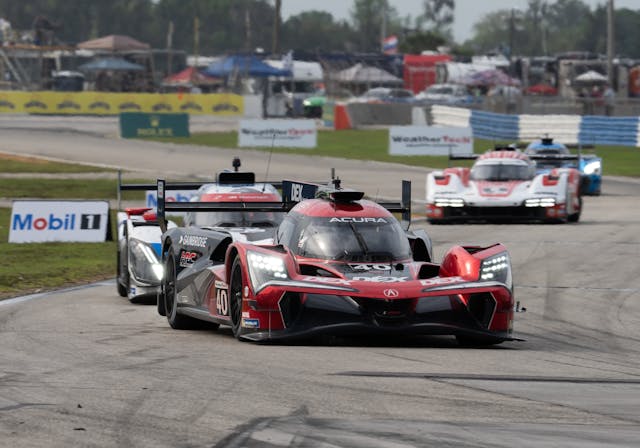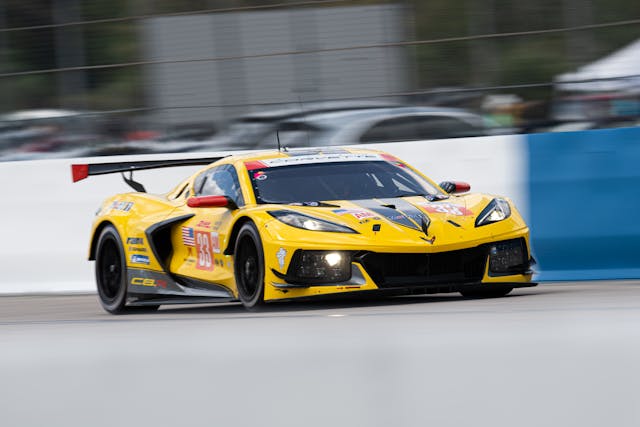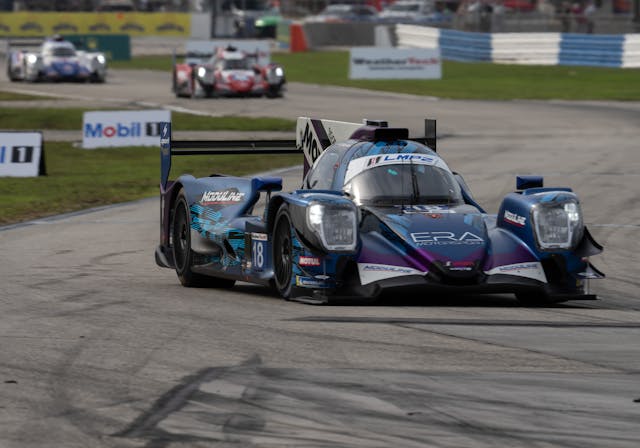7 Takeaways from the 12 Hours of Sebring’s Big Crashes and Close Finishes
The top story of the 2024 Rolex 24 at Daytona, the season-opening race for the IMSA WeatherTech SportsCar Championship in late January, was the nicely executed win by the No. 7 Penske Porsche 963. That victory notched team owner Roger Penske his first overall victory in the Rolex 24 in 55 years. At the second race of the season, Saturday’s Mobil 1 Twelve Hours at Sebring, the Penske Porsches certainly figured into the race, with the No. 7 coming in third.
This time, however, the lead story was the intense GTP battle in the closing stages between the Acura ARX-06 of Wayne Taylor Racing with Andretti, and the Chip Ganassi Racing Cadillac V-Series.R.
Acura’s Louis Deletraz and Cadillac pilot Sebastien Bourdais put on a racing driver’s seminar, fighting the very rough, dark track, slower-lapped cars, and each other. Deletraz made a brilliant move with just five minutes left to squeeze by Bourdais and drive on to a victory margin of just 0.981 seconds.
That was sort of the story of all four classes in the race: LMP2 was decided by 1.127 seconds; GTD Pro by 0.121 seconds, and GTD by 0.646 seconds: incredibly tight finishes before what IMSA said was, like Daytona, a record crowd, though IMSA, owned by NASCAR, quit announcing crowd sizes in 2013. The complete results are available here.

Deletraz, just starting his first full IMSA season, co-drove with Jordan Taylor and IndyCar star Colton Herta, while Bourdais co-drove with Renger van der Zande and IndyCar’s Scott Dixon. It’s worth noting that a week ago, Chip Ganassi and Cadillac announced they’d be ending their partnership at the end of 2024. No real reason was given.
The race was, according to Bourdais, a little too physical, with multiple contacts between him and Deletraz. “Definitely, that was way too many contacts,” Bourdais said. “Both sides of the floor, toward the rear, are significantly damaged. I think we were both be pretty lucky it didn’t rip a stem off a wheel because we probably could have picked up a puncture four or five times during the last few laps there. I’m not really accustomed to that and not a big fan of it. To be honest, I don’t think he needed it because he had so much pace. Hats off to them anyhow. They had the package at the end to make the difference. We just had to settle for second.”
The LMP2 winner was, like Daytona, the Era Motorsport Oreca. In GTD Pro, it was the Vasser-Sullivan Lexus RCF GT3, after a very disappointing Daytona. And in GTD, it was a repeat for the Rolex 24 winner, the Winward Racing Mercedes-AMG GT3.
What else did we learn at Sebring? Read on:
1: Two spectacular crashes, no injuries: If any one driver has owned Sebring the last 10 years, it’s probably Pipo Derani, currently a driver for the No. 31 Whelen Cadillac. He won in 2023 and set a fast time in qualifying this year. In the seventh hour, leading by a whopping 12 seconds, he was passing a slower car, a Ferrari 296 GT3 driven by Miguel Molina; they made contact. It was enough to upset Derani’s Cadillac and send the car onto the grass and head-on into the tire wall, and then the Cadillac flipped and landed upside-down atop that tire wall. Just like that, the favorite was done.
The other crash occurred on the final turn leading to the front straight. Katherine Legge, driving the Gradient Racing Acura NSX GT3, was making the right turn when Fred Makowiecki, driving a Penske Porsche 963, took the turn to Legge’s inside rather than wait and make the pass on the straightaway, and appeared to boot the Acura into the wall, hard. She walked away, but the car was done.
2: Once again, the Corvettes and the Mustangs have teething pains: We expected it at the Rolex 24 at Daytona, where the highest-finishing Mustang came in sixth in class and 31st overall, in a 59-car field. The top Corvette finished fifth in class and 30th overall. And while the new-this-year Ford Mustang GT3 and Chevrolet Corvette Z06 GT.R benefitted from another seven weeks of testing and development time, the 12 Hours of Sebring finish saw the two Multimatic Mustangs finish seventh and eighth in class, but the Corvettes didn’t have much to show for a hard-fought day.
The top-finishing Corvette was ninth in the 22-car GTD class—one of the AWA-backed cars, not one of the favored Pratt Miller Corvettes, which finished tenth and 11th in GTD Pro, a class that only had 12 cars. The GTD Pro finishes don’t tell the story, as the No. 3 car was hit from behind and spun in the closing minutes of the race while running second. “It was very hectic out there and people were acting over-aggressive,” said the victimized Corvette driver, Dani Juncadella. “It gets dark here and there’s not much (camera) footage, so people start believing there are no rules.” The number 4 sister car battled clutch problems all day, with the crew eventually choosing to change the clutch, which cost multiple laps. The other AWA Corvette made it only two laps before being sidelined with electrical issues.

3: The dreaded BOP: No one much likes IMSA’s “Balance of Performance,” a formula the sanctioning body uses to level the playing field among the cars in each class, as well as level out the class itself. Let’s get to that one first: BOP ensures that the GTP class is the fastest, followed by the LMP2 class, followed by the GTD Pro and GTD classes, which use the same cars, but GTD Pro allows for additional professional drivers.
In the race itself, GTP cars averaged lap times of about mid-1 minute, 49 seconds, up to 1:50 or so. That kept them well ahead of the LMP2 cars, which are limited to spec-500-horsepower V-8s, and lap around mid-1:51s, up to 1.53. GTD and GTD Pro lapped in the low 2:01 range, up to 2:02.
It’s still remarkable that the rules allow such a wide variety of makes and models to fit in such narrow windows. It’s a combination of regulating horsepower, fuel flow, airflow, weight, aerodynamics, and other sophisticated factors. But balancing V-8s against V-6s, naturally-aspirated vs. turbocharged, and front-engine vs. mid-engine is a science, and sports car racing has it down.
4: The Lamborghini cometh. We initially saw the all-new Lamborghini SC63 the first week of last December at an IMSA open test at Daytona International Speedway, sort of a quieter Roar before the mandatory Roar Before the 24. Since the Lamborghini wasn’t racing at Daytona, it didn’t show for the official test but did for the preliminary one. There, surprisingly, it was the fastest GTP on the track.
We aren’t sure what happened between December and March, when the Lamborghini formally debuted at the 12 Hours of Sebring. It was now slower than most of the field. BOP, we’d guess. But it was a good day for the Lambo, finishing seventh out of 11 GTP cars and on the lead lap, thanks in part to an all-star driver lineup, including Romain Grosjean. Well done.
5: Youth is served, part 2: As it was at the Rolex 24 at Daytona in the LMP2 class, the winning Era Motorsport Oreca LMP2 07 featured 17-year-old Connor Zilisch, teamed with Era regular-season drivers Dwight Merriman and Ryan Dalziel. But this time, Zilisch was tasked with finishing the race, taking over with about 90 minutes left. He drove like a veteran. If Connor Zilisch were on the stock market, I’d buy some shares. Zilisch spent most of his young pro racing career in the Trans Am Series, winning 10 times in the TA2 class, and winning his debut race in the top TA class. It was the first time in Trans Am history that one driver had won both the TA and TA2 race in the same weekend.
Zilisch signed a NASCAR development deal with Trackhouse Racing, and he makes his NASCAR Craftsman Truck debut this weekend with Spire Motorsports at Circuit of the Americas. Said IMSA co-driver Dalziel, himself an overall winner at the Rolex 24, on Zilisch’s final stint at Sebring: “You look at the list of drivers that were behind Connor on that restart—the talent and the guys with experience—and the kid just kept his head cool and brought it home.”

6: The Michelin Pilot Challenge series is healthy, too: Friday’s opening act for both the Twelve Hours of Sebring and the Rolex 24 at Daytona is the dual-class Michelin Pilot Challenge, a four-hour race at Daytona, and two hours at Sebring. The Alan Jay Automotive Network 120 at Sebring was the usual rough-and-tumble affair, with 40 cars total in the GS class (such as the Aston Martin Vantage GT4, Ford Mustang GT4, Toyota Supra GT4), and the less powerful TCR class (Hyundai Elantra N TCR, Honda Civic FK7 TCR, Alfa Romeo Giulietta Veloce TCR).
First taking the checkered flag were Frank DePew and Robin Liddell in the Rebel Rock Racing Aston Martin Vantage AMR GT4 Evo, 1.8 seconds ahead of the van der Steur Racing Aston Martin. In TCR, the winner was the JDC-Miller Motorsports Audi RS3 LMS TCR of Chris Miller and Mikey Taylor, over the Star-Com Racing Hyundai Elantra, which was elevated from third after the second-place Hyundai failed post-race inspection.
7. Two races in, two record crowds and large fields: Only IMSA starts its season with what are, by far, its two biggest races. Race three is pretty important, though: the 100-minute Acura Grand Prix of Long Beach, April 19-20. Eight more races follow, ending with the 10-hour Petit Le Mans at Michelin Raceway Road Atlanta. In a surprise move, IMSA announced its 2025 schedule at the Sebring weekend, and it looks pretty much like this year’s. With 18 manufacturers paying to compete in it, pound for pound, IMSA may be America’s healthiest race series.
***
Check out the Hagerty Media homepage so you don’t miss a single story, or better yet, bookmark it. To get our best stories delivered right to your inbox, subscribe to our newsletters.



For now the BOP is pretty even in most classes.
I agree as soon as it gets dark the crashing starts. I would like to see more lights to cut down on this. There were some very dirty moves made at the end. it is increasing each year.
Not to the top two cars as they raced hard and clean.
I wonder if Andretti will split from Taylor and pick Cadillac. It would be a nice way to give a F team experience before their car arrives.
The nighttime racing does seem to look like it needs an upgrade. I agree hyperv6, more lights or better lights.
Congrats to Lexus for doing well with the RC F GT3!